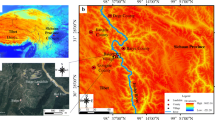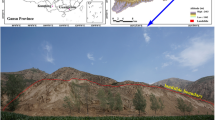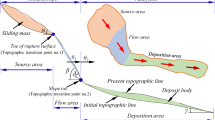Abstract
Rapid long-runout landslides always cause extensive damage to lives and properties, and the deposit characteristics of landslides play an important role in revealing the evolution and transport mechanism. Several intensive fieldworks were conducted at the Jiweishan landslide region in Chongqing, China to investigate the deposit features, including the motion characteristics, retention of stratigraphic sequence, inverse grading, and thickness distribution, which later helped in the calibration and setting of the numerical modeling. Based on the discrete element method (DEM), the effects of simulation parameters (friction coefficient, volume, and fall height) on the maximum travel distance and deposit area of the landslide were assessed, taking account into the joints network developed in rock mass, respectively. Sensitivity analysis was performed according to numerical data, and the calculated relative sensitivity (RS) values suggested that all parameters had an impact on the travel distance of rapid long-runout landslides, and the sensitivity could be listed in the following order of most to least sensitive: volume (RS = 0.83) > fall height (RS = 0.23) > friction coefficient (RS = 0.14).

















Similar content being viewed by others
References
Barton N, Choubey V (1977) The shear strength of rock joints in theory and practice. Rock Mech 10:1–54
Cagnoli B, Romano GP (2010) Effect of grain size on mobility of dry granular flows of angular rock fragments: an experimental determination. J Volcanol Geotherm Res 193:18–24
Crosta GB, Imposimato S, Roddeman D (2009) Numerical modelling of entrainment/deposition in rock and debris-avalanches. Eng Geol 109:135–145
Cruden DM, Hungr O (1986) The debris of the Frank Slide and theories of rockslide–avalanche mobility. Can J Earth Sci 23:425–432
Dade WB, Huppert HE (1998) Long-runout rockfalls. Geology 26:803–806
Davies TR (1982) Spreading of rock avalanche debris by mechanical fluidization. Rock Mech 15:9–24
Di Luzio E, Bianchi-Fasani G, Esposito C, Saroli M, Cavinato GP, Scarascia-Mugnozza G (2004) Massive rock-slope failure in the Central Apennines (Italy): the case of the Campo di Giove rock avalanche. Bull Eng Geol Environ 63:1–12
Erismann TH (1979) Mechanisms of large landslides. Rock Mech 12(1):15–46
Ge YF, Kulatilake PHSW, Tang HM, Xiong CR (2014) Investigation of natural rock joint roughness. Comput Geotech 55:290–305
Ge YF, Tang HM, Li W, Wang LQ, Wu YP, Yi XL et al (2016) Evaluation for deposit areas of rock avalanche based on features of rock mass structure. Earth Sci 33:3873–3884
Habib P (1975) Production of gaseous pore pressure during rock slides. Rock Mech 7(4):193–197
Hao MH, Xu Q, Yang XG, Peng T, Zhou JW (2015) Physical modeling tests on inverse grading of particles in high speed landslide debris. Chin J Rock Mech Eng 34:472–479
Hewitt K, Clague JJ, Orwin JF (2008) Legacies of catastrophic rock slope failures in mountain landscapes. Earth Sci Rev 87:1–38
Hsu KJ (1975) Catastrophic debris streams (sturzstroms) generated by rockfalls. Geol Soc Am Bull 86(1):129–140
Hungr O, Evans SG (2004) Entrainment of debris in rock avalanches: an analysis of a long run-out mechanism. Geol Soc Am Bull 116(9–10):1240–1252
Kent PE (1966) The transport mechanism in catastrophic rock falls. J Geol 74:79–83
Kulatilake PHSW, Ge YF (2014) Investigation of stability of the critical rock blocks that initiated the Jiweishan landslide in China. Geotech Geol Eng 32:1291–1315
Lajeunesse E, Quantin C, Allemand P, Delacourt C (2006) New insights on the runout of large landslides in the Valles-Marineris canyons, Mars. Geophys Res Lett 33:1–4
Legros F (2002) The mobility of long-runout landslides. Eng Geol 63:301–331
Li DQ, Xiao T, Cao ZJ, Zhou CB, Zhang LM (2016) Enhancement of random finite element method in reliability analysis and risk assessment of soil slopes using Subset Simulation. Landslides 13:293–303
Liu HC, Zhang ZY (1986) The mechanism of huge landslides in overconsolidated clay near Longyang Gorge damsite. J Chengdu Univ Technol 13:94–104
Manzella I, Labiouse V (2008) Qualitative analysis of rock avalanches propagation by means of physical modelling of non-constrained gravel flows. Rock Mech Rock Eng 41:133–151
McEwen AS (1989) Mobility of large rock avalanches: evidence from Valles Marineris, Mars. Geology 17(12):1111–1114
Melosh HJ (1990) Giant rock avalanches. Nature 348:483–484
Okura Y, Kitahara H, Sammori T, Kawanami A (2000) The effects of rockfall volume on runout distance. Eng Geol 58:109–124
Scheidegger AE (1973) On the prediction of the reach and velocity of catastrophic landslides. Rock Mech 5:231–236
Sousa RL, Karam K, Einstein HH (2014) Exploration analysis for landslide risk management. Georisk 8:155–170
Strom AL (2004) Rock avalanches of the Ardon River valley at the southern foot of the Rocky Range, Northern Caucasus, North Osetia. Landslides 1:237–241
Tang CL, Hu JC, Lin ML, Angelier J, Lu CY, Chan YC, Chu HT (2009) The Tsaoling landslide triggered by the Chi-Chi earthquake, Taiwan: insights from a discrete element simulation. Eng Geol 106:1–19
Wang YF, Xu Q, Cheng QG, Li Y, Luo ZX (2016) Spreading and deposit characteristics of a rapid dry granular avalanche across 3D topography: experimental study. Rock Mech Rock Eng 49:4349–4370
Wu JH, Chen CH (2011) Application of DDA to simulate characteristics of the Tsaoling landslide. Comput Geotech 38:741–750
Xing AG, Yuan XY, Xu Q, Zhao QH, Huang HQ, Cheng QG (2017) Characteristics and numerical runout modelling of a catastrophic rock avalanche triggered by the Wenchuan earthquake in the Wenjia valley, Mianzhu, Sichuan, China. Landslides 14:83–98
Xu Q, Fan XM, Huang RQ, Yin YP, Hou SS, Dong XJ et al (2010) A catastrophic rockslide-debris flow in Wulong, Chongqing, China in 2009: background, characterization, and causes. Landslides 7:75–87
Yang YY, Hu XL, Wang LQ, Zhang GC (2011) Long runout rockfall-landslides and their forming conditions. J Eng Geol 19:809–815
Yarnold JC (1993) Rock-avalanche characteristics in dry climates and the effect of flow into lakes: insights from mid-Tertiary sedimentary breccias near Artillery Peak, Arizona. Geol Soc Am Bull 105:345–360
Yin YP, Sun P, Zhang M, Li B (2011) Mechanism on apparent dip sliding of oblique inclined bedding rockslide at Jiweishan, Chongqing, China. Landslides 8:49–65
Zhou JW, Cui P, Yang XG (2013) Dynamic process analysis for the initiation and movement of the Donghekou landslide-debris flow triggered by the Wenchuan earthquake. J Asian Earth Sci 76:70–84
Acknowledgements
This work was supported by the National Key R&D Program of China (grant number 2017YFC1501303) and the National Natural Science Foundation of China (grant number 41602316). The authors also thank the anonymous reviewers for their insightful and valuable comments.
Author information
Authors and Affiliations
Corresponding author
Additional information
Highlights
• The deposit features of the Jiweishan landslide were revealed through field investigation and numerical modeling.
• Considering the small-scale joints developed in rock mass in the failure region, the numerical results corresponded to the field investigation.
• The effects of the Jiweishan landslide parameters on the travel distance and deposit area were investigated based on numerical simulation, and the sensitivity order is as follows: volume > fall height > friction coefficient.
Rights and permissions
About this article
Cite this article
Ge, Y., Tang, H., Ez Eldin, M.A.M. et al. Deposit characteristics of the Jiweishan rapid long-runout landslide based on field investigation and numerical modeling. Bull Eng Geol Environ 78, 4383–4396 (2019). https://doi.org/10.1007/s10064-018-1422-3
Received:
Accepted:
Published:
Issue Date:
DOI: https://doi.org/10.1007/s10064-018-1422-3




